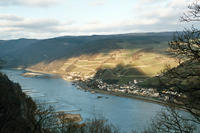You are in: Europe -> Germany -> Upper Middle Rhine Valley, and traditional search or Image Gallery will yield results of this site only
Upper Middle Rhine Valley
| Site number: | 1066 |
|
| Type of site: | Cultural | |
| Date: | - | |
| Date of Inscription: | 2002 | |
| Location: | Europe, Germany, States of Rhineland-Palatinate (Rheinland-Pfalz) and Hesse (Hessen) | |
| Video: |
|
Up to 75 images are shown here. Click on each for more details or on Image Gallery for more images.
| Description: | The Middle Rhine Valley stretching 65km encompasses castles, historic towns and vineyards. The site vividly demonstrates its long history of the involvement of the inhabitants with their striking and varied natural landscape. With its close association with history and legend, it has exercised a powerful influence on writers, artists and composers of many centuries. --WHMNet paraphrase from the description at WHC Site, where additional information is available. | |
| The Rhine Gorge is a popular name for the Upper Middle Rhine Valley, a 65 km section of the River Rhine between Koblenz and Bingen in Germany. It was added to the UNESCO list of World Heritage Sites in June 2002 for a unique combination of geological, historical, cultural and industrial reasons. The region's rocks were laid down in the Devonian period and are known as Rhenish Facies. This is a fossil-bearing sedimentary rock type consisting mainly of slate. The rocks underwent considerable folding during the Carboniferous period. The gorge was carved out during a much more recent uplifting to leave the river contained within steep walls 200 m high, the most famous feature being the Loreley. The gorge produces its own microclimate and has acted as a corridor for species not otherwise found in the region. Its slopes have long been terraced for agriculture, in particular viticulture which thrives on south-facing slopes. The river has been an important trade route into central Europe since prehistoric times and a string of small settlements has grown up along the banks. Constrained in size, many of these old towns retain a historic feel today. With increasing wealth, many castles appeared and the valley became a core region of the Holy Roman Empire. It was at the centre of the Thirty Years' War, which left many of the castles in ruins, a particular attraction for today's cruise ships which follow the river. At one time forming a border of France, in the 19th Century the valley became part of Prussia and its landscape became the quintessential image of Germany. This part of the Rhine features strongly in folklore, such as a legendary castle on the Rhine being the setting for the opera Götterdämmerung. The annual Rhine in Flames festivals include spectacular firework displays at Sankt Goar in September and Koblenz in August, the best view being from one of a convoy of boats. --Wikipedia. Text is available under the Creative Commons Attribution-ShareAlike License. | ||
| Source: | http://whc.unesco.org/en/list/1066 | |
| Source2: | http://whc.unesco.org/en/list/1066/video | |
| Reference: | 1. UNESCO World Heritage Center, Site Page. | |


 NHK World Heritage 100 series
NHK World Heritage 100 series





























